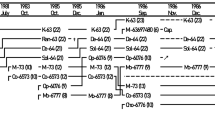Abstract
Arashiyama A troop was transplanted from Japan to Texas, U.S.A. in February 1972 and released into a large outdoor enclosure (42 ha) in a semi-free ranging condition. Agonistic behavior was quantified during the first six months after the release. Agonistic interactions occurred at about one incident per 100 monkeys every 2 to 9 minutes. In general, peaks in frequency of agonistic interactions coincided with peaks in feeding activity. 97.5% of all incidents were of a “mild” type, and 85.7% were simple one-to-one, unidirectional interactions. “Severe” forms of agonistic behavior occurred only during the first month and then only rarely. Adult females and juveniles were initiators in about 93% of all cases. In general, the more severe the form of attack, the more pronounced was the form of submission.
Similar content being viewed by others
References
Alexander, B. K. &J. M. Bowers, 1968. The social structure of the Oregon troop of Japanese macaques.Primates, 8: 333–340.
————, 1970. The effects of acute crowding on aggressive behavior of Japanese macaques.Behaviour, 39: 73–89.
Bernstein, I. S. &T. P. Gordon, 1974. The function of aggression in Primate societies.Amer. Scientist, 62: 304–311.
————, 1974. Aggression and social controls in rhesus monkeys (Macaca mulatta) groups revealed in group formation studies.Folia primat., 21: 81–107.
Casey, D. E. &T. W. Clark, 1976. Some spacing relations among the central male of a transplanted troop of Japanese macaques (Arashiyama West).Primates, 17: 433–450.
Clark, T. W., 1975. Transplantation and adaptation of a troop of Japanese macaques to a Texas brushland habitat. Unpubl. 415 p.
---- &T. Mano, 1975. Transplantation and adaptation of Arashiyama A troop of Japanese macaques to a Texas brushland habitat.Contemporary Primatology, 358–361.
Eaton, G., 1971. The Oregon troop of Japanese macaques,Macaca fuscata.Primate News, 9: 4–9.
Gartlan, J. S., 1968. Structure and function in primate society.Folia primat., 8: 89–120.
Gouzoules, H., L. M. Fedigan, &L. Fedigan, 1975. Responses of a transplanted troop of Japanese macaques (Macaca fuscata) to bobcat (Lynx rufus) prediation.Primates, 16: 335–349.
Hall, K. R. L., 1964. Aggression in monkey and ape societies. In:The Natural History of Aggression,J. D. Carthy &F. J. Ebling (eds.), Academic Press, London. 159 p.
Imanishi, K., 1952. Evolution of the human characteristics. In:Man,K. Imanishi (ed.), Mainichi-shinbun-sha, Tokyo, pp. 36–94. (in Japanese).
----, 1965. Identification: a process of socialization in the subhuman society ofMacaca fuscata. In:Japanese Monkeys—A Collection of Translations,S. Altman (ed.).
Kawai, M., S. Azuma, &K. Yoshiba, 1967. Ecological studies of reproduction in Japanese monkeys (Macaca fuscata): I. Problems of the birth season.Primates, 8: 35–74.
Kawamura, S., 1956. Prehuman culture.Shizen, 11: 28–35. (in Japanese).
Marsden, H. M., 1973. Aggression within social groups of rhesus monkeys (Macaca mulatta): effect of contact between groups.Anim. Behav., 21: 247–249.
Miyadi, D., 1964. Social life of Japanese monkeys.Science, 143: 783–786.
Norikoshi, K., 1971. Tests to determine the responsiveness of free-ranging Japanese monkeys in food-getting situations.Primates, 12: 113–124.
Rioch, D., 1967. Discussion of agonistic behavior. In:Social Communication Among Primates,S. A. Altman (ed.), Chicago Univ. Press, Chicago, pp. 115–122.
Rowell, T., 1967. Social organization in primates. In:Primate Ethology,D. Morris (ed.), Aldine, London, pp. 219–235.
Southwick, C. H., 1967. An experimental study of intra group agonistic behavior in rhesus monkeys (Macaca mulatta).Behaviour, 28: 182–209.
————, 1969. Aggressive behavior of rhesus monkeys in natural and captive groups.Proc. Symp. on the Biol, of Aggression, Milan, May 1968, Excerpta Medica, Amsteridam.
Sugiyama, Y., 1910. On the division of natural troop of Japanese monkeys at Takasakiyama.Primates, 2: 109–148.
Tokuda, K. &G. D. Jensen, 1968. The leader's role in controlling aggressive behavior in a monkey group.Primates, 9: 319–322.
Yamada, M., 1957. A case of acculturation in the subhuman society of Japanese monkeys.Primates, 1: 30–46 (in Japanese).
————, 1966. Five natural troops of Japanese monkeys in Shodoshima Island (1): distribution and organization,Primates, 7: 315–362.
Author information
Authors and Affiliations
About this article
Cite this article
Clark, T.W. Agonistic behavior in a transplanted troop of Japanese macaques: Arashiyama west. Primates 19, 141–151 (1978). https://doi.org/10.1007/BF02373231
Received:
Accepted:
Issue Date:
DOI: https://doi.org/10.1007/BF02373231




